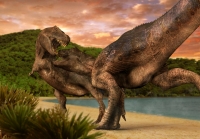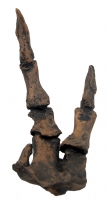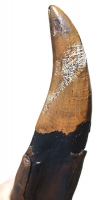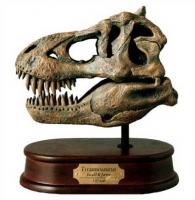
HOME | NEWS | INTERACTIVES | FEATURES | STORE

HOME | NEWS | INTERACTIVES | FEATURES | STORE
New Bird-Like Dinosaur Related to Archaeopteryx
Three Feathered Tyrannosaurs Discovered
Woolly Mammoth DNA Adapted for Ice Age Survival
Rare Find: Three New Dinosaurs From Australia
Flute Belonged to Early Humans
Jurassic Dino Provides Clues to Bird Wing Evolution
Hobbit-Like Human Ancestor Found
Evolution Can Occur in Less Than Ten Years
Gigantic Trilobite Fossils Found in Portugal

Location: Canada Alberta and Saskatchewan, USA Colorado, Montana, Wyoming, New Mexico
Time: 68 - 65 million years ago
Diet: Carnivore
Classification: Family Tyrannosauridae, Infraorder Tetanurae, Suborder Theropoda, Order Saurischia
Size: Length 43 ft (13 m), Height 13 ft (4 m) at the hips, Weight 6.3 tons

Own this T. rex poster - Only $15!
Tyrannosaurus was a bipedal carnivorous dinosaur that lived throughout what is now the western part of North America approximately 68-65 million years ago.
A member of the theropod group of dinosaurs, the popular species Tyrannosaurus rex (T. rex) is popular in many cultures around the world. The name Tyrannosaurus rex means "tyrant lizard king" in Latin.
The T. rex had a long heavy tail that helped balance it's extremely large head, along with very strong hindlegs, but unusually small forelimbs. Although small, the forelimbs were very strong and had two clawed-digits and a small metacarpal that was once a third digit. T. rex had a muscular S-curved neck that helped to support it's massive skull. The tail contained more than forty vertebrae and was very heavy. This helped maintain balance and off-set the body weight associated with the long torso and heavy skull. Many of the T. rex's bones were hollow which kept from adding additional weight to the already massive body. The hind legs of T. rex were disproportionately long in relation to body size of any other theropod.

Own your own T. rex right hand
The largest T. rex skulls found are up to 5 feet (1.5 m) long and have large openings called fenestrae where muscles attached. These openings also kept the skull from becoming too heavy. The back of the skull was very wide, but had a narrow snout which gave T. rex extremely good binocular vision. Many of the bones in the skull were fused into a honeycomb like mass that made the skulls lighter and possibly added flexibility to the bones. The bite of the T. rex was stronger than any of the non-tyrannosaurids. This was due to the U-shaped tip of the upper jaw. T. rex teeth could be up to 12 in. (30 cm) long including the root, which made them the largest of any carnivorous dinosaur.

Own your own replica of the World Record T. rex tooth
Tyrannosaurus rex is the type genus of the subfamily Tyrannosaurinae, the family Tyrannosauridae, and the superfamily Tyrannosauroidea. This means that T. rex is the benchmark that paleontologists use to measure all other species in the same group.
Tyrannosaurus rex was named by the president of the American Museum of Natural History, Henry Fairfield Osborn, in 1905. The name T. rex, which means "tyrant lizard king" in Latin, was chosen to reflect the animals' dominance over other species of the time as well as reflect it's size. T. rex teeth were found in 1874 near Golden, Colorado by A. Lakes. Post cranial elements found in Wyoming by J. B. Hatcher and fragments of vertebrae found in South Dakota by E. D. Cope were both thought to have belonged to other species, but have since been reclassified as belonging to T. rex. T
The first partial skeleton of T. rex was found by Barnum Brown, assistant curator at the American Museum of Natural History, in 1900 in eastern Wyoming. Brown found a total of 5 partial T. rex skeletons in the Western United States. Many skeletons have been found, but only one fossilized track has been recorded. This track was discovered in northeast New Mexico on the Philmont Scout Ranch in 1983 and later identified and documented.

T. rex skull - 1/10 scale polyresin
The most complete (more than 90%) T. rex skeleton was found on August 12, 1990 in the Hell Creek formation near Faith, South Dakota by amateur paleontologist Sue Hendrickson. Until 2001 this skeleton was the largest that had been found. Nicknamed "Sue" in her honor, this skeleton became the object of a legal battle over ownership. The case was settled in 1997 and ownership was given to the original land owner Maurice Williams. The skeletal remains sold for $7.6 million USD at auction. Having been reassembled and considered a prized exhibit, the collection can be seen at the Field Museum of Natural History in Chicago, IL. Upon studying the fossilized bones of "Sue" it appears that she reached full-size at age 19 and lived until age 28. This is considered the longest any tyrannosaur has lived. Her death appears to have been from a substantial bite to the head from another tyrannosaur.
In 1987 another T. rex was found near the Hell Creek formation in South Dakota and was nicknamed "Stan" after amateur paleontologist Stan Sacrison. This skeleton was 65% complete and took over 30,000 hours of digging and prep work to remove the fossils. "Stan" went on an extensive world tour and is currently on display at the Black Hills Museum of Natural History in Hill City, South Dakota. "Stan" was found to have had broken and healed ribs, and a broken and healed neck along with a hole in the back of it's skull that appeared to be the size of another tyrannosaur tooth.

1/20 scale polyresin T. rex skeleton
Jack Horner found five T. rex skeletons in Montana near the Fort Peck Reservoir in the summer of 2000. One of which was possibly the largest tyrannosaurus ever found. This specimen was called "C. rex."
In 2001 a field team from the Burpee Museum of Natural History in Rockford, IL found the first recorded juvenile T. rex. The skeleton they found was 50% complete and was named "Jane the Rockford T-rex." "Jane" is the most complete and most well preserved juvenile specimen that has been found and has been examined by several prominent paleontologists including Jack Horner, Robert Bakker, Pete Larson, and Greg Erickson. Jane can be seen at the Burpee Museum of Natural History in Rockford, IL.
A press release by Montana State University in April 2006 showed that it had recently completed reconstruction of a skull found in the 1960s that was the largest T. rex skull found to date. This skull is 59 in. (150 cm) long compared with "Sue's" skull which measures 55.4 in. (141 cm).
Tyrannosaurus rex is the most widely recognized dinosaur today. It is not uncommon for T. rex to be referred to by its full scientific name by the general public.
The Field Museum in Chicago estimated that 10,000 people made the trek to see the "Sue" exhibit on its opening day in 2003.


Free Book Download:
Geologic History of West Virginia by Dudley H. Cardwell (1977)
>> Download the Book